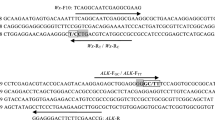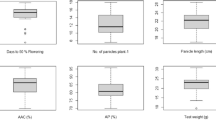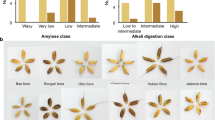Abstract
Apparent amylose content (AAC) is a key determinant of eating and cooking quality in rice and it is mainly controlled by the Wx gene which encodes a granule-bound starch synthase (GBSS). In this study, sixteen single-segment substitution lines harboring the Wx gene from 16 different donors and their recipient HJX74 were used to detect the naturally occurring allelic variation at the Wx locus. The AAC in the materials varied widely and could be grouped into glutinous, low, intermediate, and two high AAC sub-classes, high I (24.36–25.20%) and high II (25.81–26.19%), under different experimental environments, which showed a positive correlation with the enzymatic activity of GBSS. One insertion/deletion (InDel) and three single nucleotide polymorphisms in the Wx gene were detected and their combinations resulted in the variation of five classes of AAC. Based on the results of AAC phenotypes, GBSS activities and cDNA sequences, five Wx alleles, wx, Wx t, Wx g1, Wx g2, and Wx g3, were identified, two of which, Wx g2 and Wx g3, are separated for the first time in this study. Under different cropping seasons, the AAC differed significantly for the Wx t and Wx g1 alleles, with higher AAC in the fall season than in the spring season, but did not differ significantly for the wx, Wx g2, and Wx g3 alleles. In conclusion, the present results might contribute to our understanding of the naturally occurring allelic variation at the Wx locus and will facilitate the improvement of rice quality by marker-assisted selection.



Similar content being viewed by others
References
Aluko G, Martinez C, Tohme J, Castano C, Bergman C, Oard JH (2004) QTL mapping of grain quality traits from the interspecific cross Oryza sativa x O. glaberrima. Theor Appl Genet 109:630–639
Asaoka M, Okuno K, Fuwa H (1985) Effect of environmental temperature at the milky stage on amylose content and fine structure of amylopectin of waxy and nonwaxy endosperm starches of rice (Oryza sativa L.). Agric Biol Chem 49:373–379
Asaoka M, Okuno K, Konishi Y, Fuwa H (1987) The effects of endosperm mutations and environmental temperature during development on the distribution of molecular weight of amylose in rice endosperm. Agric Biol Chem 51:3451–3453
Ayres NM, McClung AM, Larkin PD, Bligh HFJ, Jones CA, Park WD (1997) Microsatellites and a single-nucleotide polymorphism differentiate apparent amylose classes in an extended pedigree of US rice germplasm. Theor Appl Genet 94:773–781
Bao JS, Corke H, Sun M (2002) Microsatellites in starch-synthesizing genes in relation to starch physicochemical properties in waxy rice (Oryza sativa L.). Theor Appl Genet 105:898–905
Bao JS, Kong XL, Xie JK, Xu LJ (2004) Analysis of genotypic and environmental effects on rice starch. 1. apparent amylose content, pasting viscosity, and gel texture. J Agric Food Chem 52:6010–6016
Bao JS, Corke H, Sun M (2006a) Microsatellites, single nucleotide polymorphisms and a sequence tagged site in starch-synthesizing genes in relation to starch physicochemical properties in nonwaxy rice (Oryza sativa L.). Theor Appl Genet 113:1185–1196
Bao JS, Shen SQ, Sun M, Corke H (2006b) Analysis of genotypic diversity in the starch physicochemical properties of nonwaxy rice: apparent amylose content, pasting viscosity and gel texture. Starch/Starke 58:259–267
Bergman CJ, Delgado JT, McClung AM, Fjellstrom RG (2001) An improved method for using a microsatellite in the rice Waxy gene to determine amylose class. Cereal Chem 78:257–260
Bligh HFJ, Till RI, Jones CA (1995) A microsatellite sequence closely linked to the Waxy gene of Oryza sativa. Euphytica 86:83–85
Bligh HFJ, Larkin PD, Roach PS, Jones CA, Fu H, Park WD (1998) Use of alternate splice sites in granule-bound starch synthase mRNA from low-amylose rice varieties. Plant Mol Biol 38:407–415
Cai XL, Wang ZY, Xing YY, Zhang JL, Hong MM (1998) Aberrant splicing of intron 1 leads to the heterogeneous 5′ UTR and decreased expression of waxy gene in rice cultivars of intermediate amylose content. Plant J 14(4):459–465
Cai XL, Liu QQ, Tang SZ, Gu MH, Wang ZY (2002) Development of a molecular marker for screening the rice cultivars with intermediate amylose content in Oryza sativa subsp. indica. J Plant Physiol Mol Biol (China) 28:137–144
Champagne ET, Bett-Garber KL, McClung AM, Bergman C (2004) Sensory characteristics of diverse rice cultivars as influenced by genetic and environmental factors. Cereal Chem 81:237–243
Chen MH, Bergman CJ, Pinsona SRM, Fjellstrom RG (2008a) Waxy gene haplotypes: associations with apparent amylose content and the effect by the environment in an international rice germplasm collection. J Cereal Sci 47:536–545
Chen MH, Bergman CJ, Pinsona SRM, Fjellstrom RG (2008b) Waxy gene haplotypes: associations with pasting properties in an international rice germplasm collection. J Cereal Sci 48:781–788
Chen MH, Fjellstrom RG, Christensen EF, Bergman CJ (2010) Development of three allele-specific codominant rice Waxy gene PCR markers suitable for marker-assisted selection of amylose content and paste viscosity. Mol Breed 26:513–523
Fan CC, Yu XQ, Xing YZ, Xu CG, Luo LJ, Zhang QF (2005) The main effects, epistatic effects and environmental interactions of QTLs on the cooking and eating quality of rice in a doubled-haploid line population. Theor Appl Genet 110:1445–1452
Han YP, Xu ML, Liu XY, Yan CJ, Korban SS, Chen XL, Gu MH (2004) Genes coding for starch branching enzymes are major contributors to starch viscosity characteristics in waxy rice (Oryza sativa L.). Plant Sci 166:357–364
He P, Li SG, Qian Q, Ma YQ, Li JZ, Wang WM, Chen Y, Zhu LH (1999) Genetic analysis of rice grain quality. Theor Appl Genet 98:502–508
He FH, Xi ZY, Zeng RZ, Zhang GQ (2005) Developing single segment substitution lines (SSSLs) in rice (Oryza sativa L.) using advanced backcrosses and MAS. Acta Genet Sin (China) 32(8):825–831
Hirano HY, Sano Y (1998) Enhancement of Wx gene expression and the accumulation of amylose in response to cool temperature during seed development in rice. Plant Cell Physiol 39:807–812
Hirano HY, Eiguchi M, Sano Y (1998) A single base change altered the regulation of the Waxy gene at the posttranscriptional level during domestication of rice. Mol Biol Evol 15:978–987
International Rice Genome Sequencing Project (2005) The map-based sequence of rice genome. Nature 436:793–800
Inukai T, Sako A, Hirano HY, Sano Y (2000) Analysis of intragenic recombination at wx in rice: correlation between the molecular and genetic maps within the locus. Genome 43:589–596
Isshiki M, Morino K, Nakajima M, Okagaki RJ, Wessler SR, Izawa T, Shimamoto K (1998) A naturally occurring functional allele of the waxy locus has a GT to TT mutation at the 5′ splice site of the first intron. Plant J 15:133–138
Isshiki M, Nakajima M, Satoh H, Shimamoto K (2000) dull: rice mutants with tissue-specific effects on the splicing of the waxy pre-mRNA. Plant J 23:451–460
Isshiki M, Yamamoto Y, Satoh H, Shimamoto K (2001) Nonsense-mediated decay of mutant waxy mRNA in rice. Plant Physiol 125:1388–1395
Juliano BO (1985) Criteria and test for rice grain quality. In: Juliano BO (ed) Rice chemistry and technology. American Association of Cereal Chemists, Inc., St. Paul, Minnesota, pp 443–513
Kaushik RP, Khush GS (1991) Genetic analysis of endosperm mutants in rice (Oryza sativa L.). Theor Appl Genet 83:146–152
Larkin PD, Park WD (1999) Transcript accumulation and utilization of alternate and non consensus splice sites in rice granule bound starch synthase are temperature sensitive and controlled by a single nucleotide polymorphism. Plant Mol Biol 40(4):719–727
Larkin PD, Park WD (2003) Association of waxy gene single nucleotide polymorphisms with starch characteristics in rice (Oryza sativa L.). Mol Breed 12:335–339
Lin SK, Chang MC, Tsai YG, Lur HS (2005) Proteomic analysis of the expression of proteins related to rice quality during caryopsis development and the effect of high temperature on expression. Proteomics 5:2140–2156
Liu GF, Zhang ZM, Zhu HT, Zhao FM, Ding XH, Zeng RZ, Li WT, Zhang GQ (2008) Detection of QTLs with additive effects and additive-by-environment interaction effects on panicle number in rice (Oryza sativa L.) with single-segment substitution lines. Theor Appl Genet 116:923–931
Liu GF, Zeng RZ, Zhu HT, Zhang ZM, Ding XH, Zhao FM, Li WT, Zhang GQ (2009) Dynamic expression of nine QTLs for tiller number detected with single segment substitution lines in rice. Theor Appl Genet 118:443–453
Marone M, Mozzetti S, Ritis DD, Pierelli L, Scambia G (2001) Semiquantitative RT-PCR analysis to assess the expression levels of multiple transcripts from the same sample. Biol Proc Online 3:19–25
Mikami I, Aikawa M, Hirano HY, Sano Y (1999) Altered tissue specific expression at the Wx gene of opaque mutants in rice. Euphytica 105:91–97
Mikami I, Dung LV, Hirano HY, Sano Y (2000) Effects of the two most common Wx alleles on different genetic backgrounds in rice. Plant Breed 119:505–508
Mikami I, Uwatoko N, Ikeda Y, Yamaguchi J, Hirano HY, Suzuki Y, Sano Y (2008) Allelic diversification at the wx locus in landraces of Asian rice. Theor Appl Genet 116(7):979–989
Nishi A, Nakamura Y, Tanaka N, Satoh H (2001) Biochemical and genetic analysis of the effects of amylose-extender mutation in rice endosperm. Plant Physiol 127:459–472
Okuno K, Fuwa H, Yano M (1983) A new mutant gene lowering amylose content in endosperm starch of rice, Oryza sativa L. Jpn J Breed 33:387–394
Peleman JD, van der Voort JR (2003) Breeding by design. Trends Plant Sci 8:330–334
Prathepha P, Baimai V (2004) Variation of Wx microsatellite allele, waxy allele distribution and differentiation of chloroplast DNA in a collection of Thai rice (Oryza sativa L.). Euphytica 140:231–237
Sano Y (1984) Differential regulation of waxy gene expression in rice endosperm. Theor Appl Genet 68:467–473
Sano Y, Maekawa M, Kikuchi H (1985) Temperature effects on the Wx protein level and amylose content in the endosperm of rice. J Hered 76:221–222
Sano Y, Katsumata M, Okuno K (1986) Genetic studies of speciation in cultivated rice. Inter-and intra-specific differentiation in the waxy gene expression. Euphytica 35:1–9
Shu QY, Wu DX, Xia YW, Gao MW, Ayres NM, Larkin PD, Park WD (1999) Microsatellites polymorphism on the Waxy gene locus and their relationship to amylose content in indica and japonica rice, Oryza sativa L. Acta Genet Sin (China) 26(4):350–358
Smith AM, Denyer K, Martin C (1997) The synthesis of the starch granule. Annu Rev Plant Physiol Plant Mol Biol 48:67–87
Tan YF, Li JX, Yu SB, Xing YZ, Xu CG, Zhang QF (1999) The three important traits for cooking and eating quality of rice grains are controlled by a single locus in an elite rice hybrid, Shanyou 63. Theor Appl Genet 99:642–648
Temnykh S, Park WD, Ayres N, Cartinhour S, Hauck N, Lipovich L, Cho YG, Ishii T, McCouch SR (2000) Mapping and genome organization of microsatellite sequences in rice (Oryza sativa L.). Theor Appl Genet 100:697–712
Tetlow IJ, Wait R, Lu ZX, Akkasaeng R, Bowsher CG, Esposito S, Hashemi BK, Morell MK, Emesa MJ (2004) Protein phosphorylation in amyloplasts regulates starch branching enzyme activity and protein–protein interactions. Plant Cell 16:694–708
Thompson JD, Gibson TJ, Plewniak F, Jeanmougin F, Higgins DG (1997) The ClustalX windows interface: flexible strategies for multiple sequence alignment aided by quality analysis tools. Nucleic Acids Res 25:4876–4882
Tian ZX, Qian Q, Liu QQ, Yan MX, Liu XF, Yan CJ, Liu GF, Gao ZY, Tang SZ, Zeng DL, Wang YH, Yu JM, Gu MH, Li JY (2009) Allelic diversities in rice starch biosynthesis lead to a diverse array of rice eating and cooking qualities. Proc Natl Acad Sci USA 106:21760–21765
Traore K, McClung AM, Chen MH, Fjellstrom R (2011) Inheritance of flour paste viscosity is associated with a rice Waxy gene exon 10 SNP marker. J Cereal Sci 53:37–44
Wanchana S, Toojinda T, Tragoonrung S, Vanavichit A (2003) Duplicated coding sequence in the waxy allele of tropical glutinous rice (Oryza sativa L.). Plant Sci 165:1193–1199
Wang ZY, Zheng FQ, Shen GZ, Gao JP, Snusted DP, Li MG, Zhang JL, Hong MM (1995) The amylose content in rice endosperm is related to the post-transcriptional regulation of the waxy gene. Plant J 7(4):613–622
Wang LQ, Liu WJ, Xu Y, He YQ, Luo LJ, Xing YZ, Xu CG, Zhang QF (2007) Genetic basis of 17 traits and viscosity parameters characterizing the eating and cooking quality of rice grain. Theor Appl Genet 115:463–476
Xi ZY, He FH, Zeng RZ, Zhang ZM, Ding XH, Li WT, Zhang GQ (2006) Development of a wide population of chromosome single-segment substitution lines in the genetic background of an elite cultivar of rice (Oryza sativa L.). Genome 49:476–484
Yano M, Okuno K, Kawakami J, Satoh H, Omura T (1985) High amylose mutants of rice, Oryza sativa L. Theor Appl Genet 69:253–257
Yano M, Okuno K, Satoh H, Omura T (1988) Chromosomal location of genes conditioning low amylose content of endosperm starches in rice (Oryza sativa L.). Theor Appl Genet 76:183–189
Young ND, Tanksley SD (1989) Restriction fragment length polymorphism maps and the concept of graphical genotypes. Theor Appl Genet 77:95–101
Zeng RZ, Zhang ZM, He FH, Xi ZY, Akshay T, Shi JQ, Qin LJ, Huang CF, Zhang GQ (2006) Identification of multiple alleles at the Wx Locus and development of single segment substitution lines for the alleles in rice. Rice Sci 13(1):9–14
Zhang GQ, Zeng RZ, Zhang ZM, Ding XH, Li WT, Liu GM, He FH, Tulukdar A, Huang CF, Xi ZY, Qin LJ, Shi JQ, Zhao FM, Feng MJ, Shan ZL, Chen L, Guo XQ, Zhu HT, Lu YG (2004) The construction of a library of single segment substitution lines in rice (Oryza sativa L.). Rice Genet Newsl 21:85–87
Acknowledgments
This research was funded by the grants from the National Natural Science Foundation of China (30870074 and U1031002).
Author information
Authors and Affiliations
Corresponding author
Additional information
Bin Teng and Ruizhen Zeng contributed equally to this work.
Electronic supplementary material
Below is the link to the electronic supplementary material.
Rights and permissions
About this article
Cite this article
Teng, B., Zeng, R., Wang, Y. et al. Detection of allelic variation at the Wx locus with single-segment substitution lines in rice (Oryza sativa L.). Mol Breeding 30, 583–595 (2012). https://doi.org/10.1007/s11032-011-9647-x
Received:
Accepted:
Published:
Issue Date:
DOI: https://doi.org/10.1007/s11032-011-9647-x




